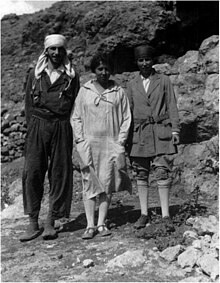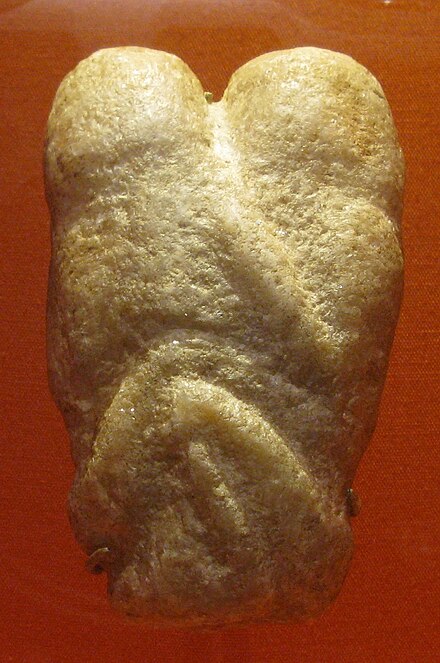sooda
Veteran Member
Natufian culture | Revolvy

Natufian culture

The Epipaleolithic Natufian culture ([1]) existed from around 12,000 to 9,500 BC[2][3] or 13,050 to 7,550 BC[4] in the Levant, a region in the Eastern Mediterranean. The culture was unusual in that it supported a sedentary or semi-sedentary population even before the introduction of agriculture. The Natufian communities may be the ancestors of the builders of the first Neolithic settlements of the region, which may have been the earliest in the world. Natufians founded Jericho which may be the oldest city in the world. Some evidence suggests deliberate cultivation of cereals, specifically rye, by the Natufian culture, at Tell Abu Hureyra, the site of earliest evidence of agriculture in the world.[5] The world's oldest evidence of bread-making has been found at Shubayqa 1, a 14,500 year old site in Jordan's northeastern desert.[6] In addition, the oldest known evidence of beer, dating to approximately 13,000 BP, was found at the Raqefet Cave in the Carmel Mountain near Haifa in Israel, in which it was used by the semi-nomadic Natufians for ritual feasting.[7][8]
Generally, though, Natufians exploited wild cereals. Animals hunted included gazelles.[9] According to Christy G. Turner II, there is archaeological and physical anthropological evidence for a relationship between the modern Semitic-speaking populations of the Levant, Persian Gulf and the Natufians.[10]Archaeogenetics have revealed derivation of later (Neolithic to Bronze Age) Levantines primarily from Natufians, besides substantial admixture from Chalcholithic Anatolians.[11]
Dorothy Garrod coined the term Natufian based on her excavations at Shuqba cave (Wadi an-Natuf) located in the western Judean Mountains.
Discovery


Dorothy Garrod (centre) discovered the Natufian culture in 1928
The Natufian culture was discovered by British archaeologist Dorothy Garrod during her excavations of Shuqba cave in the Judaean Hills.[12][13] Prior to the 1930s, the majority of archaeological work taking place in British Palestine was biblical archaeology focused on historic periods, and little was known about the region's prehistory. In 1928, Garrod was invited by the British School of Archaeology in Jerusalem (BSAJ) to excavate Shuqba cave, where prehistoric stone tools had been discovered by a French priest named Alexis Mallon four years earlier. She discovered a layer sandwiched between the Upper Palaeolithic and Bronze Age deposits characterised by the presence of microliths. She identified this with the Mesolithic, a transitional period between the Palaeolithic and the Neolithic which was well-represented in Europe but had not yet been found in the Near East.
A year later, when she discovered similar material at el-Wad Terrace, Garrod suggested the name the Natufian culture", after Wadi an-Natuf that ran close to Shuqba. Over the next two decades Garrod found Natufian material at several of her pioneering excavations in the Mount Carmel region, including el-Wad, Kebara and Tabun, as did the French archaeologist René Neuville, firmly establishing the Natufian culture in the regional prehistoric chronology. As early as 1931, both Garrod and Neuville drew attention to the presence of stone sickles in Natufian assemblages and the possibility that this represented a very early agriculture.[13]

Remains of a wall of a Natufian house
Settlements occur in the woodland belt where oak and Pistacia species dominated. The underbrush of this open woodland was grass with high frequencies of grain. The high mountains of Lebanon and the Anti-Lebanon, the steppe areas of the Negev desert in Israel and Sinai, and the Syro-Arabian desert in the east were much less favoured for Natufian settlement, presumably due to both their lower carrying capacity and the company of other groups of foragers who exploited this region.[28]
The habitations of the Natufian were semi-subterranean, often with a dry-stone foundation. The superstructure was probably made of brushwood. No traces of mudbrick have been found, which became common in the following Pre-Pottery Neolithic A (PPNA). The round houses have a diameter between three and six meters, and they contain a central round or subrectangular fireplace. In Ain Mallaha traces of postholes have been identified. Villages can cover over 1,000 square meters. Smaller settlements have been interpreted by some researchers as camps. Traces of rebuilding in almost all excavated settlements seem to point to a frequent relocation, indicating a temporary abandonment of the settlement. Settlements have been estimated to house 100–150 people, but there are three categories: small, medium, and large, ranging from 15 sq. m to 1,000 sq. m. There are no definite indications of storage facilities.

The Ain Sakhri lovers. British Museum: 1958,1007.1
The Ain Sakhri lovers, a carved stone object held at the British Museum, is the oldest known depiction of a couple having sex. It was found in the Ain Sakhri cave in the Judean desert.[29]
continued
Natufian culture | Revolvy

Natufian culture
The Epipaleolithic Natufian culture ([1]) existed from around 12,000 to 9,500 BC[2][3] or 13,050 to 7,550 BC[4] in the Levant, a region in the Eastern Mediterranean. The culture was unusual in that it supported a sedentary or semi-sedentary population even before the introduction of agriculture. The Natufian communities may be the ancestors of the builders of the first Neolithic settlements of the region, which may have been the earliest in the world. Natufians founded Jericho which may be the oldest city in the world. Some evidence suggests deliberate cultivation of cereals, specifically rye, by the Natufian culture, at Tell Abu Hureyra, the site of earliest evidence of agriculture in the world.[5] The world's oldest evidence of bread-making has been found at Shubayqa 1, a 14,500 year old site in Jordan's northeastern desert.[6] In addition, the oldest known evidence of beer, dating to approximately 13,000 BP, was found at the Raqefet Cave in the Carmel Mountain near Haifa in Israel, in which it was used by the semi-nomadic Natufians for ritual feasting.[7][8]
Generally, though, Natufians exploited wild cereals. Animals hunted included gazelles.[9] According to Christy G. Turner II, there is archaeological and physical anthropological evidence for a relationship between the modern Semitic-speaking populations of the Levant, Persian Gulf and the Natufians.[10]Archaeogenetics have revealed derivation of later (Neolithic to Bronze Age) Levantines primarily from Natufians, besides substantial admixture from Chalcholithic Anatolians.[11]
Dorothy Garrod coined the term Natufian based on her excavations at Shuqba cave (Wadi an-Natuf) located in the western Judean Mountains.
Discovery

Dorothy Garrod (centre) discovered the Natufian culture in 1928
The Natufian culture was discovered by British archaeologist Dorothy Garrod during her excavations of Shuqba cave in the Judaean Hills.[12][13] Prior to the 1930s, the majority of archaeological work taking place in British Palestine was biblical archaeology focused on historic periods, and little was known about the region's prehistory. In 1928, Garrod was invited by the British School of Archaeology in Jerusalem (BSAJ) to excavate Shuqba cave, where prehistoric stone tools had been discovered by a French priest named Alexis Mallon four years earlier. She discovered a layer sandwiched between the Upper Palaeolithic and Bronze Age deposits characterised by the presence of microliths. She identified this with the Mesolithic, a transitional period between the Palaeolithic and the Neolithic which was well-represented in Europe but had not yet been found in the Near East.
A year later, when she discovered similar material at el-Wad Terrace, Garrod suggested the name the Natufian culture", after Wadi an-Natuf that ran close to Shuqba. Over the next two decades Garrod found Natufian material at several of her pioneering excavations in the Mount Carmel region, including el-Wad, Kebara and Tabun, as did the French archaeologist René Neuville, firmly establishing the Natufian culture in the regional prehistoric chronology. As early as 1931, both Garrod and Neuville drew attention to the presence of stone sickles in Natufian assemblages and the possibility that this represented a very early agriculture.[13]
Remains of a wall of a Natufian house
Settlements occur in the woodland belt where oak and Pistacia species dominated. The underbrush of this open woodland was grass with high frequencies of grain. The high mountains of Lebanon and the Anti-Lebanon, the steppe areas of the Negev desert in Israel and Sinai, and the Syro-Arabian desert in the east were much less favoured for Natufian settlement, presumably due to both their lower carrying capacity and the company of other groups of foragers who exploited this region.[28]
The habitations of the Natufian were semi-subterranean, often with a dry-stone foundation. The superstructure was probably made of brushwood. No traces of mudbrick have been found, which became common in the following Pre-Pottery Neolithic A (PPNA). The round houses have a diameter between three and six meters, and they contain a central round or subrectangular fireplace. In Ain Mallaha traces of postholes have been identified. Villages can cover over 1,000 square meters. Smaller settlements have been interpreted by some researchers as camps. Traces of rebuilding in almost all excavated settlements seem to point to a frequent relocation, indicating a temporary abandonment of the settlement. Settlements have been estimated to house 100–150 people, but there are three categories: small, medium, and large, ranging from 15 sq. m to 1,000 sq. m. There are no definite indications of storage facilities.
The Ain Sakhri lovers. British Museum: 1958,1007.1
The Ain Sakhri lovers, a carved stone object held at the British Museum, is the oldest known depiction of a couple having sex. It was found in the Ain Sakhri cave in the Judean desert.[29]
continued
Natufian culture | Revolvy

